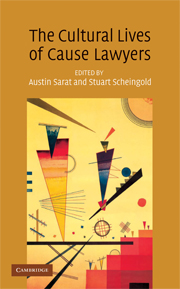Book contents
- Frontmatter
- Contents
- Acknowledgments
- Contributors
- Bringing Cultural Analysis to the Study of Cause Lawyers: An Introduction
- PART I THE CULTURAL WORK OF CAUSE LAWYERS
- PART II THE CULTURAL CONSTRUCTION OF LAWYERS AND THEIR CAUSES
- 4 “They all have different policies, so of course they have to give different news”: Images of Human Rights Lawyers in the British Press
- 5 Ed Fagan and the Ethics of Causes: Who Stole Identity Politics?
- 6 Of Windmills and Wetlands: The Press and the Romance of Property Rights
- 7 “The Kids are Alright”: Cause Lawyering on Television in 1960s America
- 8 Nothing to Believe In – Lawyers in Contemporary Films About Public Interest Litigation
- 9 “Of course he just stood there; he's the law”: Two Depictions of Cause Lawyers in Post-Authoritarian Chile
- 10 Paulina Escobar as Cause Lawyer: “Litigating” Human Rights in the Shadows of Death and the Maiden
- PART III THE CULTURAL RECEPTION OF LAWYERS AND THEIR CAUSES
- Index
4 - “They all have different policies, so of course they have to give different news”: Images of Human Rights Lawyers in the British Press
Published online by Cambridge University Press: 08 January 2010
- Frontmatter
- Contents
- Acknowledgments
- Contributors
- Bringing Cultural Analysis to the Study of Cause Lawyers: An Introduction
- PART I THE CULTURAL WORK OF CAUSE LAWYERS
- PART II THE CULTURAL CONSTRUCTION OF LAWYERS AND THEIR CAUSES
- 4 “They all have different policies, so of course they have to give different news”: Images of Human Rights Lawyers in the British Press
- 5 Ed Fagan and the Ethics of Causes: Who Stole Identity Politics?
- 6 Of Windmills and Wetlands: The Press and the Romance of Property Rights
- 7 “The Kids are Alright”: Cause Lawyering on Television in 1960s America
- 8 Nothing to Believe In – Lawyers in Contemporary Films About Public Interest Litigation
- 9 “Of course he just stood there; he's the law”: Two Depictions of Cause Lawyers in Post-Authoritarian Chile
- 10 Paulina Escobar as Cause Lawyer: “Litigating” Human Rights in the Shadows of Death and the Maiden
- PART III THE CULTURAL RECEPTION OF LAWYERS AND THEIR CAUSES
- Index
Summary
“What readers get when they pick up their newspaper – and what they miss when newspapers do not arrive – is a particular way of structuring events, of producing ‘the news’ as a coherent reality.”
ACH Smith, Paper Voices“They all have different policies, so of course they have to give different news.”
Evelyn Waugh, ScoopIntroduction
It has been suggested that cause lawyers' moral commitments have the potential to legitimate and even enhance the public's view of the legal profession. The likelihood of this occurring clearly depends on first, whether the public recognizes such a commitment in the work of cause lawyers, and second, whether the public subscribes to the particular moral principles underlying that work. These questions help focus our attention on the content of the messages about cause lawyers disseminated through the media. Recent developments in Great Britain provide an opportunity to examine in detail how one group of cause lawyers has been depicted by the nation's newspapers and to ask whether these depictions conform to a vision of the common good that is shared by newspapers and their readers.
The 1998 Human Rights Act (HRA) subjected all public authorities in the United Kingdom to the restrictions of the European Convention on Human Rights. The HRA greatly expanded the opportunities for Britons to challenge government officials in court; it also magnified the importance of lawyers who actually handle such cases.
- Type
- Chapter
- Information
- The Cultural Lives of Cause Lawyers , pp. 141 - 171Publisher: Cambridge University PressPrint publication year: 2008
- 1
- Cited by

